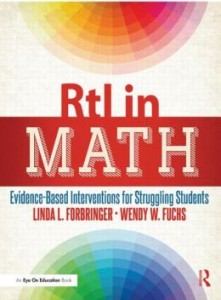An Explicit Instructional Approach to Teaching Math
RTI in Math: Evidence-Based Interventions for Struggling Students
By Linda L. Forbringer and Wendy W. Fuchs
(Routledge/Eye on Education, 2014 – Learn more)

This new text would most effectively serve new teachers as well as experienced teachers who are new to teaching mathematics to struggling learners. In the introduction and again in the conclusion, Forbringer and Fuchs highlight the NAEP data which speaks to the national need for enhanced mathematics instruction.
The authors strongly advocate for an explicit instruction approach to teaching mathematics to struggling learners, while speaking to the value of a balance approach.
After examining pertinent research, NMAP [USED National Mathematics Advisory Panel] concluded that conceptual understanding, computational fluency, and problem-solving skills are mutually supportive and that all three are important components of high-quality instruction (NMAP, 2008). When adopting material for a core curriculum, districts should therefore select programs that balance conceptual understanding, computational and procedural fluency, and problem solving.” (p. 28)
They also reference the “explicit inquiry routine” model developed by Deshler et.al. (2009) that combines elements of explicit instruction with elements of inquiry-style instruction.
It “gives students more input in the early stages of the lesson. The teacher asks a series of carefully scaffolded questions to lead the students through the representational process, monitoring their responses in an extended guided practice activity…” (pp.82-83).
Responses to common student errors

Chapters introduce a clear focus and then provide definitions; a rationale for the approach taken;details about how to teach/assess the related standards; links to related information in future chapters; detailed examples and sample lesson plans, and then a summary of the key elements from the chapter just completed.
The authors’ examples address common errors at the elementary and middle school levels. They also address common concerns in teaching English language learners and students with IEPs.
What’s in the book
- An overview of Response to Intervention (RtI) relative to mathematics, with clear operational definitions, principles and guidelines for fidelity of implementation of a multi-tiered system of supports.
- The use of assessment for instructional decision-making:
- One of the text’s strengths is the rich array of resources it provides. For instance, in this chapter, there’s a helpful annotated list of organizations, books, and assessment websites that provide teachers with additional support for implementation. (pp.10-12)
- The discussion of error/problem analysis is well done, including one table of 20 probe questions to consider when evaluating student understanding (p.18) and another to help determine implementation fidelity of the selected intervention plan.
- A set of evidence-based practices for teaching core curriculum per recommendations from the Institute of Education Sciences Practice Guide.
- They address the considerations of expectations for mastery learning in the context of a spiral curriculum and the importance of following the sequence of concrete manipulatives, representational models, and abstract symbols (CRA) even with older students.
- It was interesting that the authors recommend that “Topics such as data analysis, measurement, and time should be de-emphasized for students receiving support in Tiers 2 and 3 until the students have mastered the foundational skills. Because of its intense focus on foundational skills, Tier 2 and 3 instruction will not necessarily align with the content being presented in the general classroom. However, since Tier 2 instruction is provided in addition to Tier 1 instruction students receiving tiered support will still be exposed to the supplemental content when they are in the general education classroom.” (p.32)
- Motivation issues and a discussion of the use of incentives and praise (pp.42-54).
- Explicit instruction: A rationale, the role of working memory, guidance in lesson design, and multiple examples of verbatim lesson plans and various teaching aids.
- The revisiting of the importance of using the CRA teaching sequence, and how to implement it, citing researchers regarding the amount of successful practice at each stage necessary before proceeding.
- Developing number sense.
- including analogies between developing one-to-one correspondence in mathematics and developing sound-symbol fluency in reading (p.92);
- with attention to helping students develop and understanding of equality (p. 116), and
- clear visual models for different models representing multiplication (p. 129) and then partitive and measurement division (p.132).
- Developing computational fluency through focused, distributed practice.
Throughout the text the authors provide many explicit, operational definitions and often very detailed examples. For instance, in Chapter 8: “…computational fluency…generally considered to mean that students can compute each fact in three seconds or less. Basic facts include the 100 addition facts formed by combining two single-digit addends, the 100 related subtraction facts, the 100 multiplication facts formed by two single–digit factors, and their related division facts. Because zero cannot be used as a divisor, there are only 90 division facts.” (p.152)
- CRA Strategies to support understanding of rational numbers.
- including three models used to illustrate fraction concepts (185)
- clear explanation of division of fractions that will help students understand why they are following the set procedures and why the answer makes sense (pp. 202-206).
- Problem-solving strategies with both visual models and scaffolding strategies.
Some minor editing issues
There is also a summary/conclusion chapter, which in addition to restating material mentioned previously, introduces a table designed to help educators through the process of evaluating interventional materials from the perspective of evidence-based practice. (pp. 250-251)
There are some minor technical issues which will probably be corrected in the next printing, a couple of which could affect clarity in student instruction if the samples are directly transcribed. Cosmetic items include things such as duplicate listings of some texts (pp. 10-11) or repeating identical tables (pp. 38 & 40, 39 & 41). Items that might cause minor confusion include
- Substitution of an addition symbol for a multiplication symbol in a figure showing alternative algorithms for multiplication (p.134)
- Omission of the “0” before a decimal point in one problem [.5 x 4 = 2] vs. earlier on the page [0.3x 0.1 = 0.03] (p.212)
A thorough, research based resource for a wide audience
Forbinger and Fuchs’ RtI in Math: Evidence-Based Interventions for Struggling Students is a detailed resource for beginning teachers, in general and special education, in K-12 and university settings. It offers clear definitions, thorough instructional rationales, recommended procedures, and examples as well as an extensive list of print and on-line resource materials and suggestions of games that can support student learning.
Dr. Frances Loose has served as a special education teacher, consultant, administrator and university instructor. Most of her experience in local and regional school districts focused on serving students with learning disabilities and supporting their families and teachers. She also served as Michigan Department of Education’s special education data manager. She has a Ph.D. in Special Education Administration from Michigan State University and a BS and MA in Special Education from the University of Michigan.




























